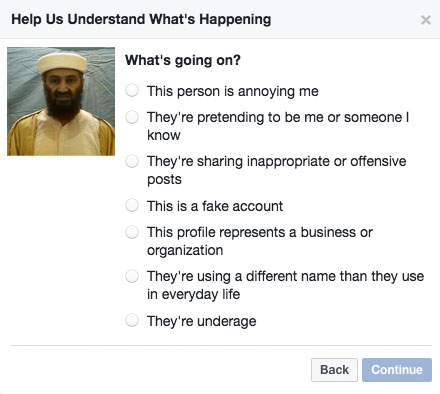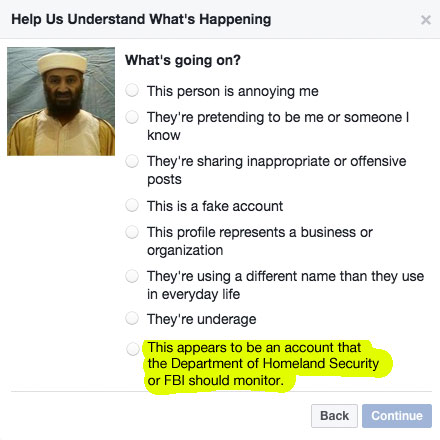What Would You Do If You Found a Facebook Profile of Someone You Suspect Might Be a Potential Terrorist of Mass Shooter?
Suppose you’re browsing the friends of a friend or you get a strange friend request .. Or suppose you’re checking your child’s friends list, and you discover a suspicious Facebook Profile. The profile you find is loaded with photos of guns and weapons.
The timeline on the profile has an ongoing list of text phrases and memes, such as …
“Too many a$$*oles, not enough bullets …”
“That ‘look’ you get before you F&CK SH*T UP.”
“KEEP CALM AND BLOW SH*T UP”
Also on the profile are a series of photos of a person holding a variety of guns — some with threatening phrases, some with the gun aimed at the camera lens.
Too often following a mass shooting, news media reports there were signals in a Facebook profile that violence was about to occur.
How would you respond if you were concerned about the possible discovery of a terrorist or mass shooter suspect? … a pre-crime analysis? Would you report this to the local police? Chances are some police departments wouldn’t be interested unless there was a specific threat to a person in their community. The police might refer you to report the Facebook profile to another law agency, or they might refer you to report the profile to Facebook officials.
Would you report the profile to Facebook? Facebook has two likely routes for submitting reports from an ellipsis (…) button on the upper right of computer screens on the Cover Photo. The two likely options for reporting a threatening suspect are … (1) Report something shared by profile (reporting individual posts), and (2) Report this profile (reporting the whole profile).
If you want to report something shared by the profile, you are instructed by Facebook about how to report the individual phrase or photo. By reporting one threatening photo or multiple photos, you might not be able to point out a pattern (connecting the dots) representing the potential threat of your concern. You might not be able to emphasize with this reporting route that the whole profile and personality concerns you.
That leaves the second option …
If you want to report the profile, the only path is to report “They’re sharing inappropriate or offensive posts” with options of …
(1) Nudity and pornography,
(2) Sexually suggestive, or
(3) Other.
Notice there is no category for violence, which seems deficient.
When you submit “Other” there is no section for notes to provide details or a red flag about the specifics of the problem with the profile. There is no immediate confirmation that a serious complaint would be forwarded to the proper authorities or what specific authorities might be notified. So you are left wondering if the submission might just result in a Facebook suspension, or whether an actual notification to the appropriate law enforcement agency will occur.


There is a definite possibility that an average citizen could stumble upon a suspicious profile before the Department of Homeland Security (DHS), in the process of scanning millions of social media accounts, could find a potential terrorist or domestic terrorist.
The UK publication Daily Mail reported in 2012 that The Department of Homeland Security (DHS) was forced to release a list of keywords and phrases it uses to monitor social networking sites and online media for signs of terrorist or other threats against the U.S.
“BLOW SH*T UP” is not on the list. But there is a long list of words that might trigger DHS monitoring published in the article, which copies the list of WATCH WORDS from the Department of Homeland Security.
The Electronic Privacy Information Center – a privacy watchdog group — filed a request under the Freedom of Information Act before potentially threatening to sue to obtain the release of the documents.
The result was a look at a manual from the year 2011 known as the “Analyst’s Desktop Binder” in which homeland security analysts are instructed to search for evidence of unfolding natural disasters, public health threats and serious crimes such as mall/school shootings, major drug busts, illegal immigrant busts. The “Analyst’s Desktop Binder” contains the long list of WATCH WORDS.
The manual also describes three missions of Media Monitoring Capability and Reporting Parameters for DHS:
1) Continually update existing National Situation Summaries (NSS) and International Situation Summaries (ISS) with the most recent, relevant, and actionable open source media information.
2) Constantly monitor all available open source information with the goal of expeditiously alerting the NOC Watch Team (National Operations Watch Team) and other key Department personnel of emergent situations.
3) Receive, process, and distribute media captured by DHS Situational Awareness Teams (DSAT) or other streaming media available to the NOC such as Northern Command’s (NORTHCOM) Full Motion Video (FMV) and via open sources.
There are concerns about privacy of individuals, and certainly some people would be likely to complain of a Nazi-like spying by citizens on other citizens, so the management of scenarios for citizens reporting suspected terrorists or domestic terrorists on Facebook is open to debate.
Stay informed with news from The Cardinal’s Emergencies Behind the Scenes Facebook page — Facebook.com/CardinalEmergencies. Includes links to favorite public safety and emergency rescuers and product manufacturers and safety companies that have facebook pages. Submit your pictures or just stay up-to-date on with fire, rescue, EMS and police photo galleries. Please add your public safety photo to the wall album — go direct to the Arlington Cardinal Emergencies Behind the Scenes photos. For a list of all of The Cardinal Facebook fan pages, go to Arlingtoncardinal.com/about/facebook …
Help fund The Cardinal Arlingtoncardinal.com/sponsor
